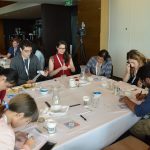How much energy do you burn using the internet?
It’s more than you think.
While a smartphone or home PC itself doesn’t burn too much energy, a tremendous amount of electricity is consumed in the massive data centres that keep us all connected via the net.
Over a hundred physicists meeting in Torquay this week may have the solution.
The physicists are part of FLEET, a new Australian Research Council funded centre developing ultra-low energy electronics.
The Torquay conference included some heavy hitters in physics, such as Prof Wolfgang Ketterle of MIT, co-winner of the 2001 Nobel Prize in Physics, and a key advisor on FLEET’s International Scientific Advisory Committee. Prof Ketterle also presented public talks in Melbourne this week, and spoke with Red Symons on ABC Radio.
Other invited speakers included Prof Q-Kun Xue (Tsinghua University) and Shaffique Adam (NUS-Yale). Prof Xue, who coordinates the collaboration between Tsinghua and FLEET, first demonstrated the quantum anomalous Hall effect. Partner Investigator Shaffique Adam specialises in the theoretical physics of Dirac systems, investigates electronic transport and other properties of novel Dirac semimetals, as well as their transition from conventional insulator to topological insulator.
Based at Peppers the Sands, Torquay, for four days from Sunday to Wednesday, the physicists and families also explored Torquay and surrounds in their spare time, with a number of delegates staying on in the area afterwards.
The workshop was unusual in the efforts made to accommodate families, partners and children, including putting on a science show to amuse the kids in the midst of scientific poster presentations (see images).
Kicking off with an afternoon targeted at improving science-communication skills of young researchers, the workshop also included two and a half days of invited talks, research tutorials to get everyone on the same page, and project updates from each of the Centre’s seven research nodes. See the program.





